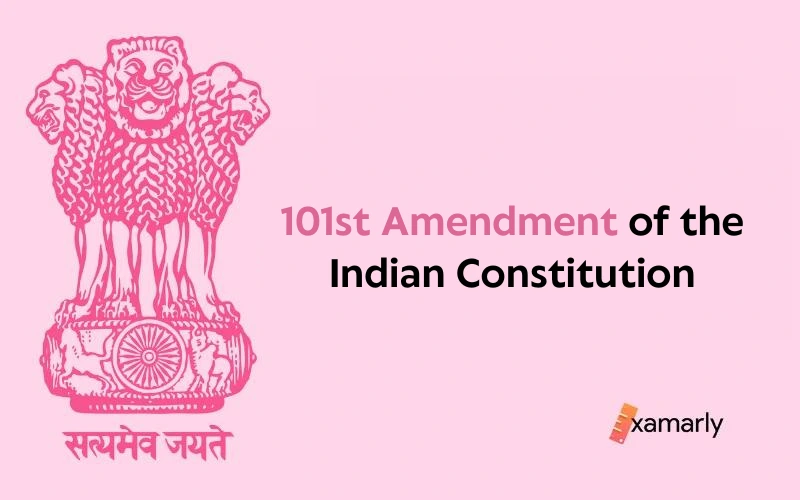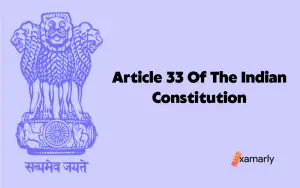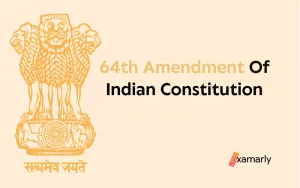101st Amendment Of the Indian Constitution, 2016 instituted a nationwide Goods and Services Tax (GST) in India on July 1, 2017. It is the Constitution of India’s One Hundred and Twenty-Second Amendment Bill.
GST is a Value Added Tax (VAT) proposed at the national level to be a comprehensive indirect tax levy on the manufacture, sale, and consumption of goods and services.
It would replace all indirect taxes levied by the Indian Central and state governments on goods and services. It is intended to be comprehensive for the majority of goods and services.
We’ve curated this blog exclusively for UPSC exam preparation, grab a pen and take down important points!
- Background
- Salient Features And Facts
- Date Enacted
- Statement Of Objects And Reasons
- Ratification Of the 101st Amendment Of the Indian Constitution
- Summing Up
- Frequently Asked Questions
- Which state passed GST first?
- When did the 101st amendment of the Indian constitution pass?
- How was the 101st Amendment of the Indian Constitution passed?
- When was GST first introduced?
- What is the difference between the 101st and 122nd amendments?
- What is the significance of the 101st Amendment to the Indian Constitution?
- What are the benefits of the 101st Amendment of the Indian Constitution?
Background
- The Vajpayee administration established an empowered union committee to streamline the GST model to be implemented and to construct the necessary back-end infrastructure for its implementation.
- P. Chidambaram, the Finance Minister, stated the goal date for the Introduction of GST as 1 April 2010 in his budget statement on 28 February 2006 and constituted another empowered committee of State Finance Ministers to design the road map.
- On November 10, 2009, the Empowered Committee of State Finance Ministers (EC) presented its First Discussion Paper on Goods and Services Tax in India, to spark debate and gather input from all stakeholders.
- The EC has proposed a dual GST module for the country. The centre has approved the dual GST concept. GST has two major components under this prototype: the Central GST, which is levied and collected by the Centre, and the State GST, which is levied and collected by the individual States.
Salient Features And Facts
- The amendment suggested a Goods and Services Tax, which would replace all existing taxes.
- The 101st Amendment to the Indian Constitution led to the creation of Article 246A.
- It conferred exclusive powers upon both the parliament and state legislatures to implement GST tax regulations for inter-state trade.
- The 101st Amendment to the Indian Constitution led to the creation of Article 246A, which conferred exclusive powers upon both the parliament and state legislatures to implement GST tax regulations for the supply of goods and services between states.
- Under Article 279A of the 101st Constitutional Amendment Act:
- The authority to establish a GST council was vested in the president.
- By order, the President shall establish the Goods and Services Tax Council within sixty days of the commencement of the Constitution (One Hundred and First Amendment) Act, 2016.
- The Union list, State list, and Concurrent list are the three distinct lists.
- These lists are in the seventh schedule.
- The Union list outlines areas on which the central government is authorised to create laws, whereas the State list specifies areas in which the state government may legislate.
- Both the central and state governments have the power to enact laws in the areas listed in the Concurrent list.
- While the GST primarily focuses on the taxation of domestic goods and services, it also covers the taxation of goods and services traded in the course of international trade or commerce, as per the provisions of the Integrated Goods and Services Tax (IGST) under the GST regime.
The Union list confers the authority to the central government to impose excise duty on the manufacturing/production of
- Petroleum crude
- High-speed diesel
- Motor spirit, natural gas
- Aviation turbine fuel.
Date Enacted
- Arun Jaitley, the then Finance Minister put forward the Constitution (One Hundred and Twenty-Second Amendment) Bill, 2014 in the Lok Sabha dated December 19, 2014. It was approved by the House on May 6, 2015.
- The Rajya Sabha referred the bill to a Committee Hearing on May 14, 2015. On July 22, 2015, the Rajya Sabha Select Committee submitted its report on the bill.
- The Rajya Sabha approved the bill on August 3, 2016, and the Lok Sabha approved the modified bill on August 8, 2016. After being ratified by the states, the bill obtained sanction from President Pranab Mukherjee on September 8, 2016.
- On the same day, it was published in The Gazette of India.
Similar Posts:
- 93rd Amendment of the Indian Constitution
- 102nd Amendment of the Indian Constitution
- 100th Amendment of the Indian Constitution
Statement Of Objects And Reasons
- The Constitution is proposed to be amended to include the goods and services tax, which would confer simultaneous power to impose taxes on the Union as well as the States, including Union territory, with the Legislature having the authority to enact laws imposing the goods and services tax on every transaction that involves the exchange of goods and services or perhaps both.
- The goods and services tax will supersede a multitude of indirect taxes imposed by the Union and state governments, to eliminate tax spiralling and create a common marketplace for products and services. The projected Central and State goods and services tax will be levied on all transactions involving the supply of merchandise and services, except those that are exempt from the tax.
- It would introduce an Integrated Goods and Services Tax on the trade of goods and services between different states.
- Central Excise duty, additional excise duty, Service Tax, additional duty of customs (equal to excise), State VAT, entertainment tax, lotteries, betting and gaming taxes, and entry tax (not paid by local bodies) would all be absorbed by GST. Other taxes that will be absorbed by GST include Octroi, entry tax, and luxury tax, resulting in a single indirect tax in India.
Ratification Of the 101st Amendment Of the Indian Constitution
- Finance Minister Arun Jaitley presented the Constitution (One Hundred and Twenty-Second Amendment) Bill, 2014 in the Lok Sabha on December 19, 2014. It was cleared by the House on May 6, 2015.
- On May 14, 2015, the Rajya Sabha submitted the proposal to a Committee. On July 22, 2015, the Rajya Sabha Select Committee presented its report on that bill.
- The Rajya Sabha approved the bill on August 3, 2016. After that, the Lok Sabha approved the modified bill on August 8, 2016.
- After being ratified by the states, the law obtained sanction from President Pranab Mukherjee on September 8, 2016. It was then published in The Gazette of India on the same day.
Summing Up
In the past, a person was required to pay a significant amount of taxes, including Central Excise Duty, Additional Excise Duty, Service Tax, Additional Customs Duty, State VAT, Entertainment Tax, and Entry Tax.
The calculation of tax was significantly simplified with the introduction of the Goods and Services Tax. The Constitution Amendment Bill 122, often known as the 101 Amendment to the Indian Constitution, advocated for the implementation of GST.
To prevent tax escalation and establish a single market for goods and services, the goods and services tax will replace numerous indirect taxes levied by the federal and state governments.
Frequently Asked Questions
Which state passed GST first?
Telangana became the first state to pass the Act, followed by Bihar on April 24. On June 15, Karnataka passed the bill. GST was implemented on June 30 at midnight from the historic Central Hall of Parliament.
When did the 101st amendment of the Indian constitution pass?
The Rajya Sabha approved the bill on August 3, 2016, and the Lok Sabha approved the modified bill on August 8, 2016.
How was the 101st Amendment of the Indian Constitution passed?
The 101st Amendment of the Indian Constitution was passed by the Parliament through the special procedure for constitutional amendments outlined in Article 368 of the Indian Constitution.
When was GST first introduced?
GST was introduced on July 1, 2017, in a grand ceremony conducted in the Central Hall of Parliament at midnight on June 30, 2017.
What is the difference between the 101st and 122nd amendments?
101 and 122 are fundamentally different from one another because 101 was the GST amendment and 122 was the bill number. The Goods and Services Tax, or GST, was established by the Constitution Amendment Bill 122 and was successfully passed under the heading of the 101 Act.
What is the significance of the 101st Amendment to the Indian Constitution?
The 101st Amendment of the Indian Constitution is a significant milestone in the history of Indian taxation as it paved the way for the implementation of the GST, which has replaced a complex system of indirect taxes with a simplified and unified tax regime.
What are the benefits of the 101st Amendment of the Indian Constitution?
The 101st Amendment of the Indian Constitution has enabled the introduction of the GST, which has led to the simplification of the tax structure in India and the creation of a unified national market.






